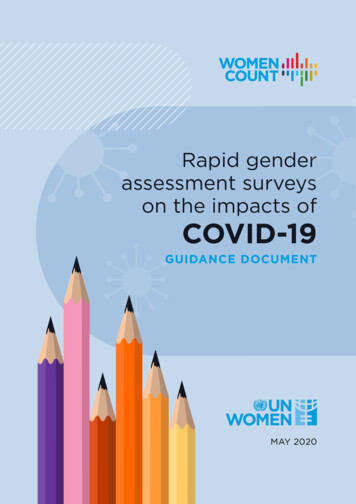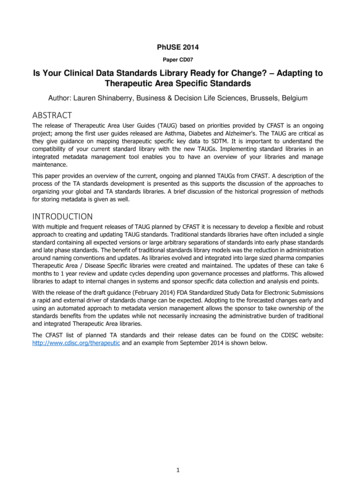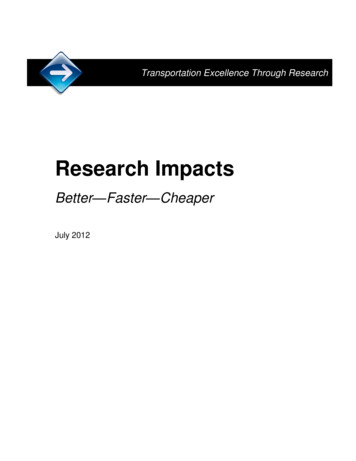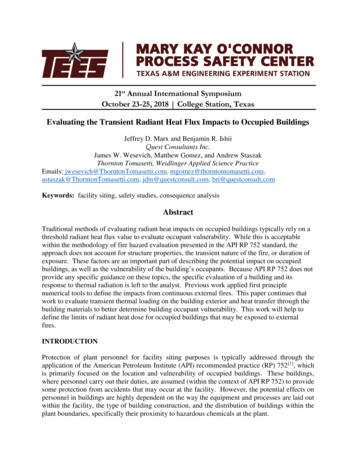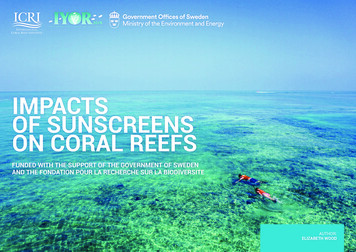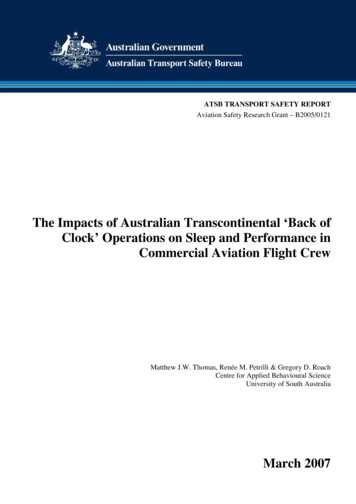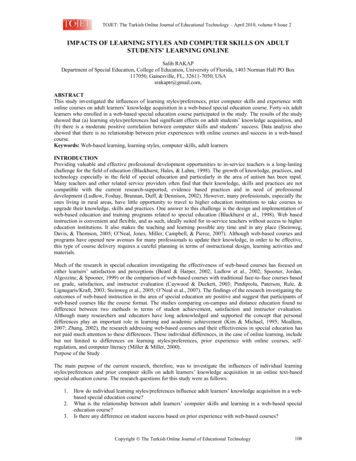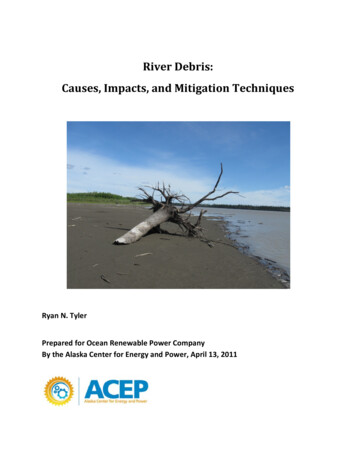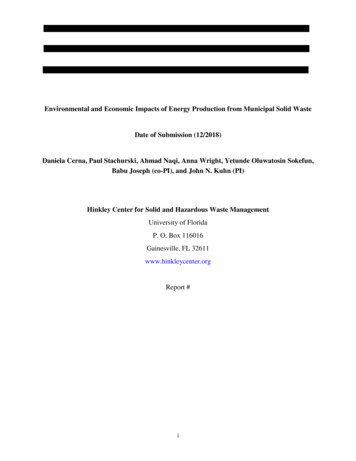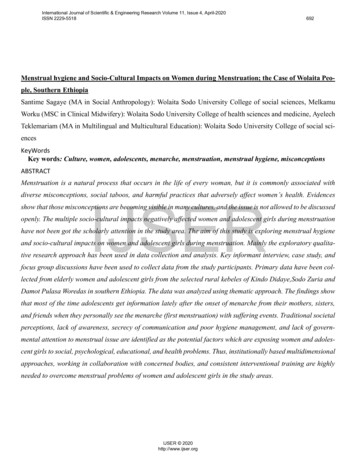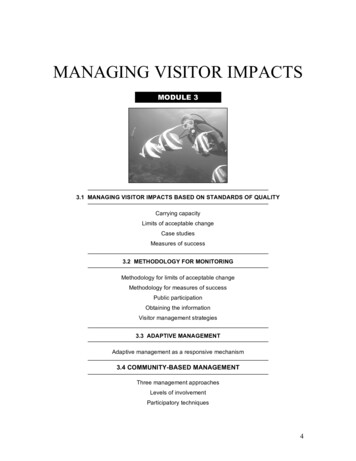
Transcription
MANAGING VISITOR IMPACTSMODULE 33.1 MANAGING VISITOR IMPACTS BASED ON STANDARDS OF QUALITYCarrying capacityLimits of acceptable changeCase studiesMeasures of success3.2 METHODOLOGY FOR MONITORINGMethodology for limits of acceptable changeMethodology for measures of successPublic participationObtaining the informationVisitor management strategies3.3 ADAPTIVE MANAGEMENTAdaptive management as a responsive mechanism3.4 COMMUNITY-BASED MANAGEMENTThree management approachesLevels of involvementParticipatory techniques4
MANAGING VISITOR IMPACTSMODULE 3AcknowledgementsThe majority of the following material is modified or excerpted from:Secretariat of the Convention on Biological Diversity. January 2002. BiologicalDiversity and Tourism: Development of Guidelines for Sustainable Tourism inVulnerable Ecosystems.Coble, TG, DH Anderson, DL Lime, TE Fish, WJ Chen, and JL Thompson. 2005.Maintaining the Quality of Resource Conditions and Visitor Experiences in Coastaland Marine Protected Areas: A Handbook for Managers. NOAA/CSC/HumanDimensions. Charleston, SC: US Department of Commerce, National Oceanic andAtmospheric Administration, Coastal Services Center.Drumm, Andy and Alan Moore. 2005. Ecotourism Development: A Manual forConservation Planners and Managers. Volume I. An Introduction to EcosystemPlanning, Second Edition. The Nature Conservancy, Arlington, Virginia, USA.Drumm, Andy, Alan Moore, Andrew Sales, Carol Patterson, and John E. Terborgh.2004. Ecotourism Development: A Manual for Conservation Planners and Managers.Volume II. The Business of Ecotourism Development and Management. The NatureConservancy, Arlington, Virginia, USA.IUCN 2004. Managing Marine Protected Areas: A Toolkit for the Western IndianOcean. IUCN Eastern African Regional Programme, Nairobi, Kenya. 172p.Salm, Rodney V., John R. Clark, and Erkki Siirila. 2000. Marine and CoastalProtected Areas: A Guide for Planners and Managers. Third edition. IUCN, Gland,Switzerland.United States Department of the Interior. Sept. 1997. The Visitor Experience andResource Protection (VERP) Framework: A Handbook for Planners and Managers.National Park Service, Denver Service Center.
MANAGING VISITOR IMPACTSMODULE 3OVERVIEWAs more people choose to live, work, and play along coasts and waterways, resourcemanagement professionals are challenged with balancing the changing demands of thepublic with the management of resources under their care. There are an array ofmanagement tools available to assist managers in understanding, monitoring andmanaging impacts created by visitors while ensuring a rich experience for the visitor.Without some means of monitoring negative visitor impacts, there is no way to tell whether thetourism at a site is truly “sustainable”, with the benefits outweighing the costs. Managementframeworks that can help determine this include new concepts of carrying capacity and the Limitsof Acceptable Change (LAC) management framework. A user-friendly decision process has beendeveloped that builds from each of these frameworks and provides a way to move from planningto implementation. This simplified, systematic approach can assist managers in identifying andmonitoring visitor impacts (to resources, to visitor experiences, and to the community), choosingmanagement tactics to address the impacts, and, finally, implementing the plan. Whatevermanagement system is chosen, stakeholders should be involved to the fullest extent possible.An adaptive management approach can help protected-area managers incorporate the on-goinginformation from monitoring programs into an effective management program. Adaptivemanagement is a “learning-by-doing” approach to management. It acknowledges theuncertainties, incomplete knowledge, and changing situations that are inherent in protected-areamanagement. Adaptive management places high emphasis on ongoing monitoring, and expectsthat policies may need to be adjusted from time to time, in order to continue moving toward theagreed-upon goals. Adaptive management can be used in conjuction with communityinvolvement principles to create an ongoing process of community-based management.LEARNING OBJECTIVES Recognize the need for and utility of visitor-use planning and management Understand the importance of monitoring visitor impacts Understand and identify effective indicators and standards for visitor impacts Apply the decision process to identified local/regional issues Learn how to apply Limits of Acceptable Change Be able to develop adaptive management responses for specific scenarios of change Understand the importance of engaging the community, and the key principles that will helpbuild bridges and forge partnerships3
MANAGING VISITOR IMPACTSMODULE 3LESSON PLAN3.1 MANAGING VISITOR USE BASED ON STANDARDS OF QUALITYIntroductionHandout 3.1 - Key Points for Addressing Visitor ImpactsPromoting recreation and tourism so that visitors can learn about and appreciate a MPA, withoutdamaging the values for which it was established, can be challenging. As we have seen inprevious modules, tourists can negatively impact both resources and the experience of othervisitors. Some of these impacts include disturbing wildlife, littering, removing “souvenirs” anddamaging mangroves, seagrass beds and reefs. Tourists may also unknowingly offend culturalstandards; for example, through improper dress, or by taking photographs of people or traditionalsites without permission. Any tourism program will result in many visitor use activities that willhave impacts, both positive and negative. An effective sustainable tourism program seeks toachieve a balance between protecting the resources and providing for enjoyment of the area byvisitors. The monitoring and managing of visitor impacts are fundamental to sustainable tourismmanagement strategies, but are often overlooked once the plan is underway.If you do not know what effects your sustainable tourism activitiesare having on the site’s natural environment and the surroundingcommunities, then you cannot say whether you are successful.If visitor impacts are not carefully monitored, gradual degradation of environmental quality canoccur without MPA staff noticing until the damage is quite far advanced. Similarly, gradualdetrimental changes may begin to occur in local communities. To detect and correct problemsbefore they proceed too far, careful monitoring of impacts, both positive and negative, needs tobe a primary activity of the site’s overall management.Be aware that monitoring will cost money and will require trained personnel and the assistance ofinterested stakeholders; but it is an essential piece of the sustainable tourism plan.To begin with, a MPA manager should have a good idea of how much tourism use the site canwithstand. If tourism becomes too intense and crosses a threshold at which impacts becomeunacceptable, the MPA manager will need to take action. How can we know where thesethresholds are, and how can we detect if they have been crossed?
MANAGING VISITOR IMPACTSMODULE 3Carrying CapacityWhat visitors do, when and where they do it, how theybehave, and protective measures at the site itself arefrequently more important in determining visitor impactsthan simply the number of visitors.The first methods developed to address tourism impacts evolved from the concept of carryingcapacity, which originated in the field of range management for grazing animals. Severaldefinitions of carrying capacity have been developed in the literature, depending on how andwhere the concept was applied. The motivations and behaviors of visitors; the mode of visitortransport and lodging; the effectiveness of guides; and the season(s) in which most use occurswill all affect impacts. As such, carrying capacity in a recreational context refers to the amountand type of use that can be accommodated in a particular area over time, while sustainingdesired biophysical resource conditions and opportunities for high-quality visitor experiences atgiven levels of management input. This concept is the conceptual underpinning for all the majorrecreation resource management frameworks in use today.In other words:Carrying capacity is the maximum amount of tourist activity that can besustained without damaging the environment or decreasing visitor enjoyment.Estimating carrying capacityQuantifying carrying capacity is difficult, and it will vary for each MPA depending on ecologicalconditions, the resilience of ecosystems to recover from disturbance (which may vary over time)and the behavior of the visitors. Often the information needed to estimate this is not available. Inmany MPAs, methods that evolved from carrying capacity are used to assess visitor impacts andhave included important recreational resource management innovations like The RecreationOpportunity Spectrum, Limits of Acceptable Change, Visitor Impact Management Planning andthe Visitor Experience and Resource Protection planning process. However, in certain situationsin which tourists tend to carry out an activity in a very predictable, consistent manner, the carryingcapacity concept can be useful.As an example, carrying capacity is commonly used to set limits for divers at coral reefs sincemost divers behave in a roughly similar way (i.e., similar lengths of time underwater). Research inthe Red Sea and Bonaire (in the Caribbean) indicate a maximum carrying capacity of 4,000-6,000divers per dive site per year. However, even in this case there is great variation between reefs.Number of divers has been assumed to be a reliable indicator of damage to the reef, howevercarrying capacity does not account for the impacts caused by the behavior of divers, the activitiesthey carry out, and the physical and ecological characteristics of a particular dive site.Spending resources on trying to quantify carrying capacity may therefore not be useful, as figuresgenerated would not be applicable indefinitely and would vary in different parts of a MPA.However, because this concept has driven a large part of the work related to visitor use withinrecreation resource management approaches, it is important to understand its application. Toomuch use can ultimately damage the MPA's natural, cultural, historical resources and the visitorexperience itself.5
MANAGING VISITOR IMPACTSMODULE 3Limits of Acceptable Change (LAC)Tthe basic steps in determining the LAC (adapted from Wallace, 1993)Handout 3.2 - Limits of Acceptable ChangeThe framework of Limits of Acceptable Change (LAC) incorporates the consideration of carryingcapacity and considers other potential underlying causes of impact. It is a decision process thataddresses unacceptable impacts to resource conditions and visitor experiences in protectedareas. The LAC involves determining whether levels of existing impact at a site areunacceptable, selecting management strategies and tactics, developing an action plan andcarrying it out, and monitoring. As with any approach, planning for monitoring occurs early andmonitoring happens throughout the process. When monitoring indicates that the threshold ofunacceptable impact has occurred, management action is taken.Carrying capacity is aimed at deciding how many people/visits a resource can sustain, while LACtries to define how much change is acceptable as a result of those visits and how to address it.The LAC assists in specifying the scope, severity, and cause of the problem ideally before itbecomes unacceptable. It encourages managers to assess a range of alternatives rather than
MANAGING VISITOR IMPACTSMODULE 3being locked in to one solution. It is a flexible system that may be tailored to the specific ecology,biodiversity, or socio-cultural considerations of each site.The LAC approach is based on three major assumptions: Impact is inevitable, so the focus is on identifying how much impact is acceptable; Different sites will have different environments and social conditions; A given level of tourism may have different impacts in these different situations.The LAC process was originally developed by the United States Forest Service for use in forestedterrestrial habitats. It is now in wide use in a variety of other locales, including many marine parks.South African National Parks have developed a similar method, based on what is termed“Thresholds for Potential Concern” for determining when management intervention is needed in acertain situation.The basic logic of the LAC process is as follows:(excerpted from VERP Handbook 1997)1. Identify two goals in conflict. In the case of protected areas, the two goals are usuallythe protection of environmental conditions and visitor experiences (goal 1) and theunrestricted access to resources for recreational use (goal 2).2. Establish that both goals must be compromised. If one or the other goal cannot becompromised, then the LAC process is not needed — one goal must simply becompromised as necessary to meet the one that cannot be compromised.3. Decide which goal will ultimately constrain the other. In the case of protected areas,the goal of protecting environmental conditions and visitor experiences will almost alwaysconstrain the goal of unrestricted access.4. Write LAC standards for this ultimately constraining goal. LAC standards expressthe minimally acceptable conditions for the environment and visitor.5. Compromise this goal only until the standards are reached. Allow the environmentalconditions and visitor experiences to degrade only to the minimally acceptable standard.Recreational access should not be substantially restricted until the standards arereached.6. Compromise the other goal as much as necessary. Once standards for environmentalconditions and visitor experiences are reached, no more degradation is allowed, andrecreational access is restricted as needed to maintain standards.Looking at the basic logic of the LAC process in this way is helpful for several reasons. First, thisway of thinking illustrates that the fundamental challenge in visitor use management is not somuch the resolution of resource protection and visitor use conflicts. Instead, the emphasis shouldbe on defining complementary visitor experience opportunities and resource conditions, and thendetermining to what extent unrestricted recreational access can be accommodated. Second, thislogic allows managers to recognize that unrestricted access — a value held strongly by manyrecreationists — is a valid goal, but one which cannot always be accommodated in light of theequally valid goals of visitor experience diversity and resource protection. Third, an understandingof the generic thought process is helpful in understanding how the various frameworks may be7
MANAGING VISITOR IMPACTSMODULE 3adapted or fine-tuned for different situations without losing the critical elements of theframeworks. Fourth, because there has been interest on the part of managers to apply the LACprocess to problems other than carrying capacity, the examination of the generic process helps indetermining the situations in which such applications may be useful and those situations in whichthey may not.With this background in mind of the basic logic of the carrying capacity and LAC approaches,consider several case studies. Which approach was used in each of the examples below? Wasthe approach effective? (We will discuss the details of how to apply LAC methodology in the nextsection.)Case studies: Galapagos and the SeychellesHandout 3.3 - Visitor Numbers at Galapagos National ParkHandout 3.4 - Cousin Island, SeychellesMethods of Controlling Excessive Visitor ImpactsHandout 3.5 – Management Options for Managing Visitor NumbersIf carrying capacity or LAC thresholds are exceeded, there are several general managementstrategies that managers can choose from to address recreational use impacts:1. Increase the supply of recreational opportunities, areas, and facilities to accommodateincreased demand.2. Reduce public use at specific sites, in individual management zones, or throughout thepark.3. Modify the character of visitor use by controlling where the use occurs, when the useoccurs, what type of use occurs, or how visitors behave.4. Alter visitor attitudes and expectations.5. Modify the site or resource by increasing the durability of the problem site, or bymaintaining or rehabilitating the site.In the above strategies, there are many specific management actions or tactics that can be used.These tactics fall into five general categories:1. Site management (e.g., facility design, the use of vegetation barriers, site hardening,area/facility closure)2. Rationing and allocation (e.g., reservations, queuing, lotteries, eligibility requirements,pricing)3. Regulation (e.g., the number of people/stock, the location or time of visits, activity, visitorbehavior, or equipment)4. Deterrence and enforcement (e.g., signs, sanctions, personnel)5. Visitor education (e.g., promote appropriate behavior, en-courage/discourage certaintypes of use, provide information regarding use conditions)
MANAGING VISITOR IMPACTSMODULE 3Examples of Specific Management Options to Reduce Visitor ImpactsWithin this general framework of strategies and tactics to reduce visitor impacts, there are a widevariety of possible actions. The list below, and the accompanying handout, gives some examples.You may be able to think of others. Seasonal or temporal limits on use, e.g. limiting visiting times; restricting car parking,accommodation facilities or public transport; ensuring visits occurs at appropriate times ofday (which may vary diurnally and seasonally) Regulating group size, particularly for specialist activities; requiring pre-registration (visitsonly by prior arrangement); providing guided tours that allow for more control and maximizeenjoyment. Restricting visitor behavior, e.g. ensuring that visitors stay on specified routes and do nottrample vegetation or disturb animals, and that noise and the use of light at night (e.g. duringvisits to turtle nesting beaches) is minimized. Using zoning, e.g. closing area to visitors, or reducing visits to ecologically important areas. Increasing entrance fees at peak periods or to popular areas. Constructing facilities and trails that reduce impact but allow more visitors and help themto see the wildlife - boardwalks, overlooks, hides, pontoons, etc. Providing garbage bins to encourage visitors to not leave litter. Educating visitors via visitor guidelines, codes of conduct, information boards, etc., madeavailable at the MPA or distributed through tourism facilities. Increased guide training to increase visitor education and monitor visitor behavior.Certain specific habitats may be amenable to specific types of management actions. Forexample, mangrove forests are commonly protected by constructing boardwalks. See theaccompanying handout for some “best management practices” for mangroves and coral reefs.Handout 3.6 - Best Management Practices for Mangroves & ReefsVisitor education should be a major component of visitor impact management. Not only can italter visitor behavior and thus directly reduce impacts, but it can also enhance the visitorexperience and spread the sustainability and conservation message. Sustainable tourism attractsan ideal audience for environmental education. Visiting mangroves and coral reefs, seeing marinemammals and other marine life, visitors want to understand what they are experiencing, as wellas the challenges of conserving these resources. At the same time, visitor guidelines for lowimpact behavior at specific sites and habits can be distributed to guides and visitors. Educationwill be discussed in more detail in a later module.)Handout 3.7 - Tips for Beach-Goers, Divers and Boaters9
MANAGING VISITOR IMPACTSMODULE 33.2 METHODOLOGY FOR MONITORING IMPACTSThe techniques outlined above require active and ongoing monitoring – of visitor numbers,indicators, visitor behavior, and so on. Without monitoring, the MPA manager cannot knowwhether a problem is develo
management is a “learning-by-doing” approach to management. It acknowledges the uncertainties, incomplete knowledge, and changing situations that are inherent in protected-area management. Adaptive management

